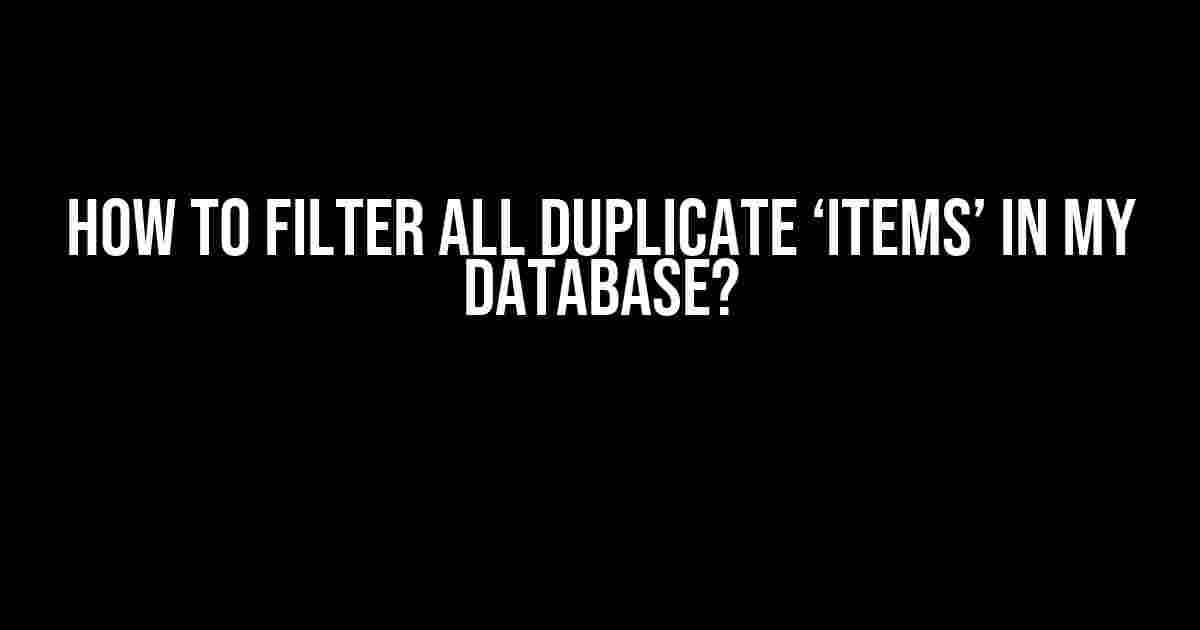Are you tired of dealing with duplicate data in your database? Do you find yourself constantly wondering how to get rid of those pesky duplicates? Well, wonder no more! In this article, we’ll show you exactly how to filter all duplicate ‘items’ in your database using SQL and other programming languages.
Why Do Duplicate Items Appear in the First Place?
Before we dive into the solution, it’s essential to understand why duplicate items appear in your database in the first place. There are several reasons why this might happen:
- User error: Sometimes, users might unintentionally enter the same data multiple times, resulting in duplicates.
- Data migration: When migrating data from one database to another, duplicates might occur due to formatting issues or incorrect data mapping.
- Data entry tools: Automated data entry tools might insert duplicate records if not properly configured.
- Database design: A poorly designed database structure can lead to duplicated data.
SQL Solutions
SQL (Structured Query Language) is a standard language for managing relational databases. Here are some SQL solutions to filter out duplicate ‘items’ in your database:
Method 1: Using the DISTINCT Keyword
The DISTINCT keyword is used to return only unique values. Here’s an example:
SELECT DISTINCT item_name
FROM items;
This query will return a list of unique item names without duplicates.
Method 2: Using the GROUP BY Clause
The GROUP BY clause is used to group rows that have the same values in one or more columns. Here’s an example:
SELECT item_name
FROM items
GROUP BY item_name
HAVING COUNT(item_name) = 1;
This query will return a list of item names that appear only once in the database, eliminating duplicates.
Method 3: Using the ROW_NUMBER() Function
The ROW_NUMBER() function is used to assign a unique number to each row within a result set. Here’s an example:
WITH duplicates AS (
SELECT item_name,
ROW_NUMBER() OVER (PARTITION BY item_name ORDER BY item_name) AS row_num
FROM items
)
SELECT item_name
FROM duplicates
WHERE row_num = 1;
This query will return a list of unique item names, eliminating duplicates.
Programming Language Solutions
If you’re using a programming language to interact with your database, you can also use the following solutions to filter out duplicate ‘items’:
Python Solution using Pandas
Pandas is a popular Python library for data manipulation and analysis. Here’s an example:
import pandas as pd
# Load data from database into a pandas dataframe
df = pd.read_sql_query("SELECT * FROM items", connection)
# Drop duplicates
df.drop_duplicates(subset='item_name', inplace=True)
# Print the resulting dataframe
print(df)
This code will load data from the ‘items’ table into a pandas dataframe, drop duplicates based on the ‘item_name’ column, and print the resulting dataframe.
JavaScript Solution using MongoDB
MongoDB is a popular NoSQL database that allows you to interact with data using JavaScript. Here’s an example:
const MongoClient = require('mongodb').MongoClient;
MongoClient.connect('mongodb://localhost:27017', (err, client) => {
if (err) {
console.error(err);
return;
}
console.log('Connected to MongoDB');
const db = client.db();
const collection = db.collection('items');
collection.aggregate([
{
$group: {
_id: "$item_name",
count: { $sum: 1 }
}
},
{
$match: { count: 1 }
}
]).toArray((err, result) => {
if (err) {
console.error(err);
return;
}
console.log(result);
});
});
This code will connect to a MongoDB database, group the ‘items’ collection by the ‘item_name’ field, and filter out duplicates by selecting only groups with a count of 1.
Best Practices for Preventing Duplicate Items
To prevent duplicate items from appearing in your database in the first place, follow these best practices:
| Best Practice | Description |
|---|---|
| Validate User Input | Validate user input to ensure it meets the required format and criteria. |
| Use Unique Identifiers | Use unique identifiers such as IDs or UUIDs to identify each item. |
| Implement Data Normalization | Implement data normalization techniques to minimize data redundancy. |
| Use Constraints and Indexes | Use constraints and indexes to enforce data integrity and improve query performance. |
| Regularly Backup and Cleanse Data | Regularly backup and cleanse data to remove duplicates and inconsistencies. |
Conclusion
In conclusion, filtering out duplicate ‘items’ in your database is a crucial task to maintain data integrity and improve query performance. By using SQL solutions, programming language solutions, and following best practices, you can ensure that your database remains duplicate-free.
Remember, prevention is better than cure. By implementing data validation, unique identifiers, data normalization, constraints, and indexes, you can prevent duplicate items from appearing in your database in the first place.
By following the instructions and explanations provided in this article, you’ll be well on your way to filtering out duplicate ‘items’ in your database and maintaining a clean and efficient data storage system.
Frequently Asked Question
Hey there, data enthusiast! Having trouble filtering out duplicate items in your database? You’re not alone! Let’s dive into the top 5 FAQs on how to de-duplicate your data.
What’s the most common reason for duplicate items in a database?
Duplicate items often occur due to data entry errors, incorrect data imports, or inadequate data cleansing processes. It’s essential to identify the root cause to prevent future duplicates from creeping in!
How do I identify duplicate items in my database?
You can use the SELECT DISTINCT statement or the GROUP BY clause to identify duplicate records. For example, SELECT DISTINCT column_name FROM table_name; or SELECT column_name, COUNT(*) FROM table_name GROUP BY column_name HAVING COUNT(*) > 1;
What’s the best way to remove duplicate items from my database?
Use a DELETE statement with a subquery to remove duplicates. For example, DELETE FROM table_name WHERE rowid NOT IN (SELECT MIN(rowid) FROM table_name GROUP BY column_name); This method ensures that only unique records remain.
Can I use indexing to prevent duplicate items in my database?
Yes, you can create a unique index on the column(s) that should contain unique values. This will prevent duplicate values from being inserted into the database in the first place. For example, CREATE UNIQUE INDEX idx_unique_column ON table_name (column_name);
How often should I run a de-duplication process on my database?
It’s a good practice to schedule regular de-duplication processes, depending on your data volume and ingest rates. You can run it daily, weekly, or monthly, ensuring that your data remains clean and duplicate-free!


